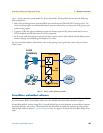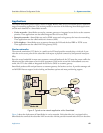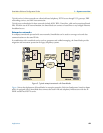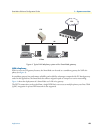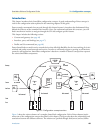
Contexts and Gateways 46
SmartWare Software Configuration Guide 2 • Configuration concepts
lines) commands. For example, you need bind commands to bind a physical port to a logical interface, and use
commands to assign profiles to contexts.
The sections that follow refer to figure 5 on page 45 and describe the concepts and elements in more
detail.
Contexts and Gateways
Context
A context represents one specific networking technology or protocol, namely IP (Internet Protocol) or CS (cir-
cuit-switching). A context can be seen as virtual dedicated equipment within the SmartNode. For example:
• A CS context contains the circuit-switching functions of the SmartNode. It can be thought of as an embed-
ded multiplexer or cross-connect within the SmartNode
• An IP context contains the routing functions of the SmartNode. It can be thought of as an embedded
router within the SmartNode
The contexts are identified by a name and contain the configuration commands that are related to the technology
they represent. A separate configuration can be built by means of the context concept for newly supported net-
work layer technologies without complicating the configuration methods of existing features. For example, as
bridging, ATM, or FR switching becomes available so a bridging, ATM, or FR context can be introduced.
Each context contains a number of interfaces, which build the connections to other SmartWare elements and
the outside world. Figure 5 on page 45 shows two contexts:
• one of type IP named router
• one of type CS named switch
Note SmartWare currently supports only one instance of the CS and IP context types.
Example
The IP context named router can contain static routes, RIP, and NAT configuration parameters. The default
circuit-switching context named switch can contain number translations, local breakout conditions, and least-
cost routing parameters.
Gateway
The concept of a gateway is introduced for the communication between contexts of different types. A gateway
handles connections between different technologies or protocols. For example, a VoIP gateway connects an IP
context to a circuit-switching context.
The gateways are each of a specific type and are identified by a name. Each named gateway contains its config-
uration parameters. With this concept, multiple vitual gateways can be instantiated and used at the same time.





